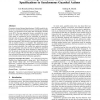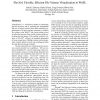167 search results - page 31 / 34 » Separation logic, abstraction and inheritance |
ICAIL
2011
ACM
12 years 9 months ago
2011
ACM
A formal two-phase model of democratic policy deliberation is presented, in which in the first phase sufficient and necessary criteria for proposals to be accepted are determine...
ISSTA
2009
ACM
14 years 4 months ago
2009
ACM
Exception analysis and points-to analysis are typically done in complete separation. Past algorithms for precise exception analysis (e.g., pairing throw clauses with catch stateme...
LCTRTS
2010
Springer
13 years 7 months ago
2010
Springer
Concurrent Action-Oriented Specifications (CAOS) model the behavior of a synchronous hardware circuit as asynchronous guarded at an abstraction level higher than the Register Tran...
POPL
2009
ACM
14 years 10 months ago
2009
ACM
This paper describes a compositional shape analysis, where each procedure is analyzed independently of its callers. The analysis uses an abstract domain based on a restricted frag...
USENIX
2008
14 years 6 days ago
2008
zation is a well-known method of abstracting physical resources and of separating the manipulation and use of logical resources from their underlying implementation. We have used ...


